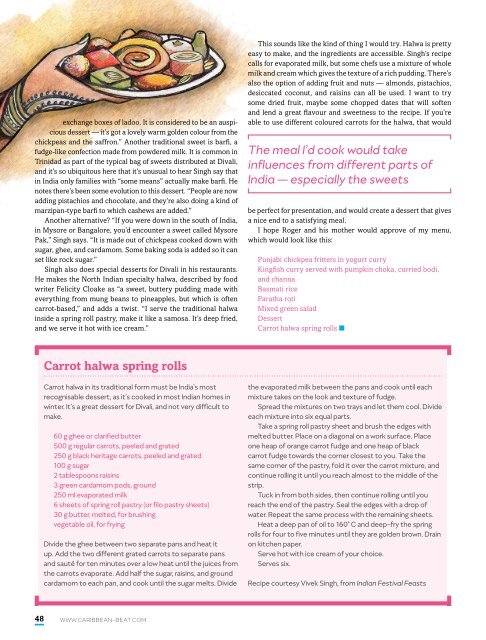Caribbean Beat — November/December 2018 (#154)
A calendar of events; music, film, and book reviews; travel features; people profiles, and much more.
A calendar of events; music, film, and book reviews; travel features; people profiles, and much more.
Create successful ePaper yourself
Turn your PDF publications into a flip-book with our unique Google optimized e-Paper software.
exchange boxes of ladoo. It is considered to be an auspicious<br />
dessert <strong>—</strong> it’s got a lovely warm golden colour from the<br />
chickpeas and the saffron.” Another traditional sweet is barfi, a<br />
fudge-like confection made from powdered milk. It is common in<br />
Trinidad as part of the typical bag of sweets distributed at Divali,<br />
and it’s so ubiquitous here that it’s unusual to hear Singh say that<br />
in India only families with “some means” actually make barfi. He<br />
notes there’s been some evolution to this dessert. “People are now<br />
adding pistachios and chocolate, and they’re also doing a kind of<br />
marzipan-type barfi to which cashews are added.”<br />
Another alternative? “If you were down in the south of India,<br />
in Mysore or Bangalore, you’d encounter a sweet called Mysore<br />
Pak,” Singh says. “It is made out of chickpeas cooked down with<br />
sugar, ghee, and cardamom. Some baking soda is added so it can<br />
set like rock sugar.”<br />
Singh also does special desserts for Divali in his restaurants.<br />
He makes the North Indian specialty halwa, described by food<br />
writer Felicity Cloake as “a sweet, buttery pudding made with<br />
everything from mung beans to pineapples, but which is often<br />
carrot-based,” and adds a twist. “I serve the traditional halwa<br />
inside a spring roll pastry, make it like a samosa. It’s deep fried,<br />
and we serve it hot with ice cream.”<br />
This sounds like the kind of thing I would try. Halwa is pretty<br />
easy to make, and the ingredients are accessible. Singh’s recipe<br />
calls for evaporated milk, but some chefs use a mixture of whole<br />
milk and cream which gives the texture of a rich pudding. There’s<br />
also the option of adding fruit and nuts <strong>—</strong> almonds, pistachios,<br />
desiccated coconut, and raisins can all be used. I want to try<br />
some dried fruit, maybe some chopped dates that will soften<br />
and lend a great flavour and sweetness to the recipe. If you’re<br />
able to use different coloured carrots for the halwa, that would<br />
The meal I’d cook would take<br />
influences from different parts of<br />
India <strong>—</strong> especially the sweets<br />
be perfect for presentation, and would create a dessert that gives<br />
a nice end to a satisfying meal.<br />
I hope Roger and his mother would approve of my menu,<br />
which would look like this:<br />
Punjabi chickpea fritters in yogurt curry<br />
Kingfish curry served with pumpkin choka, curried bodi,<br />
and channa<br />
Basmati rice<br />
Paratha roti<br />
Mixed green salad<br />
Dessert<br />
Carrot halwa spring rolls n<br />
Carrot halwa spring rolls<br />
Carrot halwa in its traditional form must be India’s most<br />
recognisable dessert, as it’s cooked in most Indian homes in<br />
winter. It’s a great dessert for Divali, and not very difficult to<br />
make.<br />
60 g ghee or clarified butter<br />
500 g regular carrots, peeled and grated<br />
250 g black heritage carrots, peeled and grated<br />
100 g sugar<br />
2 tablespoons raisins<br />
3 green cardamom pods, ground<br />
250 ml evaporated milk<br />
6 sheets of spring roll pastry (or filo pastry sheets)<br />
30 g butter, melted, for brushing<br />
vegetable oil, for frying<br />
Divide the ghee between two separate pans and heat it<br />
up. Add the two different grated carrots to separate pans<br />
and sauté for ten minutes over a low heat until the juices from<br />
the carrots evaporate. Add half the sugar, raisins, and ground<br />
cardamom to each pan, and cook until the sugar melts. Divide<br />
the evaporated milk between the pans and cook until each<br />
mixture takes on the look and texture of fudge.<br />
Spread the mixtures on two trays and let them cool. Divide<br />
each mixture into six equal parts.<br />
Take a spring roll pastry sheet and brush the edges with<br />
melted butter. Place on a diagonal on a work surface. Place<br />
one heap of orange carrot fudge and one heap of black<br />
carrot fudge towards the corner closest to you. Take the<br />
same corner of the pastry, fold it over the carrot mixture, and<br />
continue rolling it until you reach almost to the middle of the<br />
strip.<br />
Tuck in from both sides, then continue rolling until you<br />
reach the end of the pastry. Seal the edges with a drop of<br />
water. Repeat the same process with the remaining sheets.<br />
Heat a deep pan of oil to 160° C and deep-fry the spring<br />
rolls for four to five minutes until they are golden brown. Drain<br />
on kitchen paper.<br />
Serve hot with ice cream of your choice.<br />
Serves six.<br />
Recipe courtesy Vivek Singh, from Indian Festival Feasts<br />
48 WWW.CARIBBEAN-BEAT.COM


















